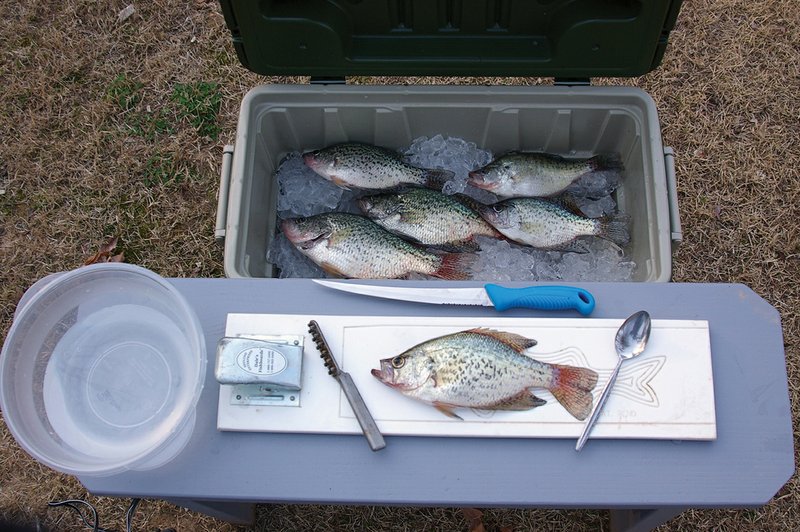We call them panfish because they are small enough to fit in a pan—a frying pan, that is. Some of those panfish we love most in Arkansas include bluegills, crappie, redear sunfish, white bass, warmouths, rock bass, yellow bass and longear sunfish. None of these fish grows very big — a few pounds tops, usually only a few ounces. But as a group, they’re among the most popular, most commonly caught fishes in The Natural State.
Panfish are great fun to catch and delicious to eat. Before the eating begins, however, anglers must know how to properly prepare their catch for the table.
Two basic ways — filleting and pan-dressing — are commonly used by Arkansas anglers. Tools you need include a sharp knife (a fillet knife, electric fillet knife and/or plain blade); a cutting board, fillet board or other hard, flat surface (use plastic or glass to reduce bacteria); a spoon or scaling tool, if you’re pan-dressing the fish; a container in which to place the prepared fish; and some newspaper, a trash bag or a bucket for disposal of waste parts. Also recommended is household bleach for cleanup.
After the fish are cleaned, they can be cooked and eaten, or you can store the fillets or pan-dressed fish in the freezer until you’re ready to prepare them. To avoid freezer burn and preserve freshness, it’s best to immerse the prepared fish in water when you freeze them (either in zip-seal plastic freezer bags or plastic containers) or, better yet, to vacuum-seal them using a product such as the Tilia FoodSaver. Be careful that the sharp fins on pan-dressed fish aren’t positioned in such a way that they could puncture the wrapping or container.
How to fillet a panfish
Nowadays, it seems most people prefer to fillet their catch to produce boneless, skinless pieces of meat ready to cook. Here’s how to do it, quick as a snap, with an electric or fixed-blade fillet knife.
To begin, lay the fish on a cutting board, fillet board or other flat, hard surface. Grasping the fish’s mouth, take the fillet knife and position it just behind the side (pectoral) fin. Slice downward to the backbone, keeping the rear of the knife blade up. Be careful not to cut into the fish’s backbone.
Next, turn the knife blade toward the tail, and continue cutting, staying on top of the back and belly fins. You’ll feel resistance as you cut through the rib cage, but be careful not to cut into the backbone. It’s better to cut too shallow than too deep. Continue your cut toward the tail, until you have almost, but not quite, cut the scaly fillet off.
Now, with the fillet barely attached to the tail, flip it away from the fish. Position your knife on the narrow portion of the fillet, and while holding the fish, slice between the meat and the skin to remove the fillet. To obtain the maximum meat, cut very close to the skin. When the fillet is removed, place it, with the rib cage still attached, on a sheet of wax paper. Then flip the fish over, and fillet the other side.
To finish, take each fillet, and with the tip of your fillet knife, carefully cut out the rib cage. To retrieve the most meat, angle your knife and slice close to the ribs. After you rinse the fillets, they’re ready to cook or store.
How to pan-dress a panfish
Some connoisseurs prefer their fish pan-dressed — with skin, tail and bones intact — to facilitate the most thorough enjoyment of these scrumptious wild treats. They don’t want to miss a single morsel, and pan-dressing eliminates the loss of the small meat pieces sometimes left behind in the filleting process. You’ll have to separate meat and bone as you eat pan-dressed fish, but many panfish gourmets believe this method of preparation produces a more tasty result.
Begin by placing the fish on a cutting board, fillet board or other hard, flat surface and scraping away all its scales with a regular tablespoon or scaling tool. Scale from the tail toward the head, being certain you remove all the scales on both sides of the fish.
Using a sharp, heavy knife, you should next remove the fish’s head. Angle the cut from just behind the top portion of the gill cover to the rear edge of the pectoral and pelvic fins, removing these fins along with the head.
Now, remove the entrails, rinse thoroughly with clean water inside and out, and you’re finished. Leave the remaining fins, the tail and skin on. These are delicious and enhance the already wonderful flavor of the fish.
